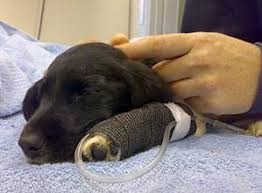How Harmful Is The ParvoVirus To Your Pet
Not so many years ago, a pet was still regarded as "just a pet", but over the past 30 years or so that perception has drastically changed. Pets have become invaluable companions for single people; research has shown that kids with who take care of pets are more socially competent and have greater role-taking skills; it has been shown that hospitalized or otherwise incapacitated patients respond positively both physically and psychologically when exposed to pets; the role of pets (especially dogs) has expanded from seeing-eye dogs to assist people with disabilities in almost all aspects of day-to-day living; pets have even been used to assist in the rehabilitation of the incarcerated who have been or are about to be paroled.
It is no wonder, then, that the beloved pet has become another member of the family, so much so that complete industries have grown rapidly to accommodate their needs. There are numerous pet sitters, pet hotels, boarding kennels, pet airport facilities, pet specialized nutrition establishments, pet spas and salons (for grooming, bathing, etc.), even pet luxury resorts, pet cemeteries and on and on. There is even insurance to cover pet health care, since it is estimated that every six seconds a pet parent faces a vet bill in excess of $3000. So it is extremely important to make sure that your pet is always in the best possible health and that pet owners remain informed about any and all threats to their pet's health.
One such threat is the Canine parvovirus type 2 (CPV2, more commonly called parvo) which is a contagious virus mainly affecting dogs, but thought to originate in cats. Wikipedia reports that parvo mutated from the feline panleukopenia into CPV2, and is highly contagious, spreading among dogs by direct or indirect contact with their feces. This virus can also be spread cross-species, from cat to dog and vice versa, and by persons, animals or anything coming in contact with infected feces. The virus is very resilient and can survive for years in your yard, on your carpet, in the dog's bowl and in just about any environment. If left untreated or not caught in time, the pet mortality rate can be as high as 91%. That is not a mis-print! Treatment often involves veterinary hospitalization and can be quite expensive. The good news is that vaccines are available and can prevent or treat this infection. There is no evidence that the virus is harmful to humans.
Symptoms
Dogs may not become ill until three days to a week after the virus attacks their immune systems. When that happens, they become lethargic and stop eating and drinking. Shortly thereafter, they begin to vomit and have diarrhea which leads to dehydration that upsets the electrolyte balance which in turn can result in a fatality to the dog. When their immune systems become severely compromised, dogs are prone to other infections as well. The normal intestinal lining is also compromised allowing blood and protein to leak into the intestines causing anemia. Endotoxins escape into the bloodstream, causing endotoxemia. Dogs develop a distinctively foul odor in the later stages of the infection while the white blood cell levels fall, further weakening the dog. Any or all of these factors can lead to shock and death.
Treatment
Survival rates depend on how quickly CPV is diagnosed, the age of the pet and aggressiveness of the treatment. Treatment usually involves extensive hospitalization, due to the severe dehydration and damage to the intestines and bone marrow. A CPV test should be given as early as possible if CPV is suspected in order to begin early treatment and increase survival rate if the disease is found.
More comprehensive treatment also consists of crystalloid IV fluids and/or colloids, antinausea injections, and broad-spectrum antibiotic injections. Antinausea and antibiotic injections are given under the skin, into the muscle or intravenously. The fluids are typically a mix of a sterile, balanced electrolyte solution, with corresponding amounts of B-complex vitamins, dextrose and potassium chloride. Analgesic medications are sometimes used to counteract the intestinal pain or discomfort caused by frequent bouts of diarrhea and vomiting.
Once the system stabilizes, the IV fluids are gradually discontinued, while bland food is slowly introduced, first intravenously and then orally. Oral antibiotics are administered for a number of days depending on the white blood cell count and the health of the patient's immune system. A puppy or infected adolescent dog with minimal symptoms can recover in as little as 2 to 3 days if the symptoms are noticed early and the CPV test confirms the diagnosis. In more severe cases, pets can remain ill from five days up to two weeks, and even with hospitalization, the mortality rate can still be very high.
Source:http://ezinearticles.com/?The-Threat-of-the-Parvovirus-to-Your-Pet&id=9307335








No comments:
Post a Comment